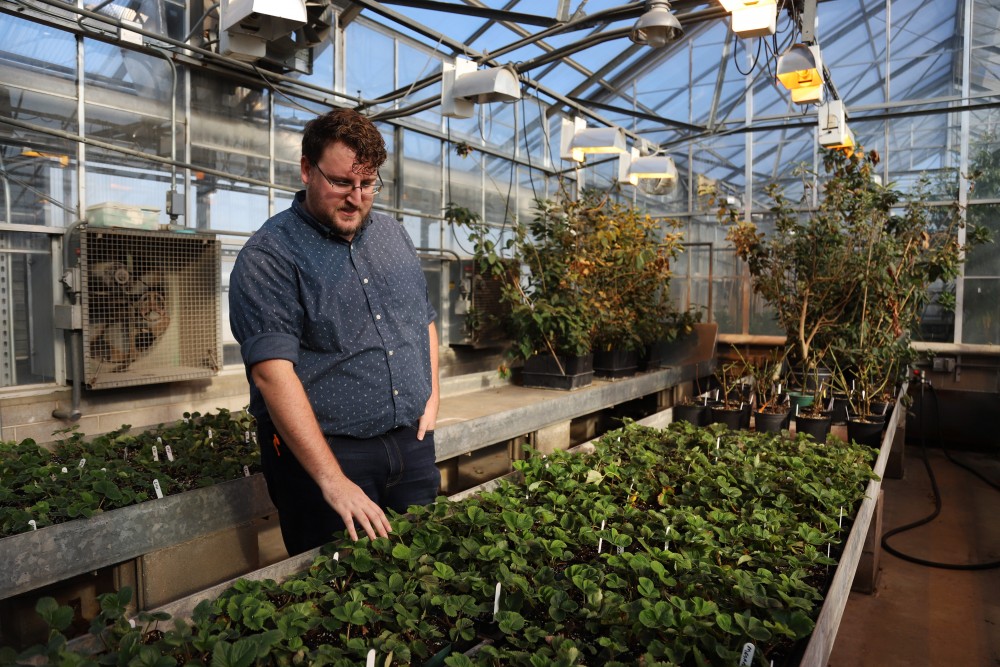University of Minnesota researcher Seth Wannemuehler wants to make the kiwiberry Minnesota’s next big fruit. The first step: explaining what a kiwiberry is.
The green berries — a close cousin of the kiwifruit — are completely hairless, approximately the size of a ping pong ball and ready to pop in your mouth, similar to a grape. But Wannemuehler said kiwiberries’ taste is what truly sets them apart: a range of sweet, tart and tropical flavors that are ripe for the mass market.
Kiwiberries are among several delicious projects underway at the University’s fruit research program, a collection of about a dozen researchers who breed, produce and improve fruit in Minnesota. From creating new varieties of apples — like the recently released First Kiss — bumping up berry production and breeding grapes suitable for the Minnesota climate, fruit researchers at the University carry on a flavorful tradition that’s been cultivated over generations.
Kiwiberries are a relatively new addition to the program. This June, the Minnesota Department of Agriculture gave the program over $91,000 to develop and breed kiwiberries as a commercial crop that could land on grocery store shelves in the not-too-distant future.
But, most Americans aren’t familiar with kiwiberries. The limited supply of U.S.-produced kiwiberries typically come from the West Coast. Wannemuehler is hoping to change that.
“In this day and age, people are more and more interested in what fruits are outside the apple-banana-orange supermarket kind of fruits,” Wannemuehler said. “One of my overall lifetime goals is to try to work to create more diversity in the marketplace for fruits.”
There’s also a more selfish reason. Wannemuehler, like many in the fruit research program, has something of a sweet tooth for new fruits like the kiwiberry.

A long road to good fruit
For apple breeder Jim Luby, the mission of the fruit research program is straightforward.
“Our overarching goal is basically getting good fruit for people to eat,” said Luby, one-half of a duo behind popular apple varieties such as the Honeycrisp.
The fruit research program, which helped develop the state’s reputation for apple breeding and introduce wine-growing to the region, is a lucrative venture. In the past three decades, fruit research has brought in over $27 million in revenue, with the large majority coming from apples.
But Luby said creating the perfect fruit can take time. Researchers essentially play matchmaker: cross-breeding plants over and over again until they have the perfect result — a sweet, crisp apple, a big red strawberry, or in the case of kiwiberries, a tropical tasting fruit that can grow in Minnesota.
Luby said new apples varieties, for example, can take 20-plus years to create; berries and grapes are closer to 10 or 15 years.
Researchers say one of the most important processes is breeding plants that can withstand the state’s cold weather while still producing good fruit.
“Cold hardiness is something of course that’s still important in Minnesota,” Luby said. “There’s not much difference between us and the North Pole when it all freezes over here.”
For many in the program, that challenge is part of the fun.
“While it’s challenging to grow fruit here because of our particular climate, it’s possible,” said Nathan Hecht, a researcher working on increasing strawberry production through natural pollinators.
Hecht said there’s growing demand for locally produced fruit in Minnesota.
“Our responsibility is to provide those resources and do that research so its possible to grow fruit productively here,” he said.
Breeding generations of researchers
Many in the fruit research program have been doing this work for a long time; Luby has worked at the University since the early 1980s.
But new generations of researchers are essential to ensuring the program continues to bear fruit, said Emily Hoover, head of the University’s Horticultural Science Department.
“[Researchers] are probably not going to see everything that they’ve done to fruition,” Hoover said. “I find people who grow fruit to be really interesting individuals who have a commitment to the long term viability of agriculture.”
Luby and Hoover, who are also married to one another, said the program is intergenerational by nature.
“We’re getting toward the end our careers and we hope to leave it full for the next generation of breeders,” Luby said.
Wannemuehler, a Ph.D. student, is one of those young researchers.
He said he wants to create a kiwiberry variety that’s cold-hardy, delicious and grown throughout Minnesota. But it will likely take several years before kiwiberries are ready for the groceries shelves — Wannemuehler’s ideal kiwiberry may take over a decade.
Wannemuehler said his role may end up being small, but it remains important to the overall mission: making fruit more delicious for Minnesotans.
“Aspirationally, I would love if through my research I could help kick off a revolution,” he said. “I see myself as someone laying the groundwork.”








